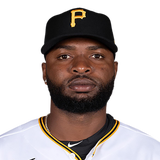
Reviewing Pittsburgh's outfield: Gregory Polanco

Going into the 2016 season, everyone considered the Pittsburgh Pirates to have one of the best group of outfielders in baseball. Andrew McCutchen, Starling Marte, and Gregory Polanco were poised to become a true three-headed monster, leading the Pirates to another postseason appearance.
In their ranks they had a bona-fide former-MVP superstar, an established regular with all the talent for further improvement, and a youngster still finding his way, with possibly even greater talent that hadn’t quite shown itself yet.
So the question becomes: how did they do? Did they meet expectations this year, exceed the best case scenarios, or fall flat? Well, it turns out, they pretty much did all three. Here is the final part in our three-part series, on Gregory Polanco.
Part 1: Andrew McCutchen
Part 2: Starling Marte
Compared to Marte’s level of consistency, Polanco has been a bit of a mixed bag in previous years. Getting to the majors as a 22-year-old, he has always had the potential to blossom into a great player, and there have been bursts here and there, but Pirate fans have been waiting somewhat patiently for Polanco to break out. First, a reasonable ZiPS projection going into this year:
151 games, 627 PA’s, 12 HR, 63 RBI, 25 SB, .254/.317/.389, 2.2 WAR
That, again, seems to be a reasonable expectation for a player still only 24 years old. Instead, we got this so far:
133 games, 547 PA’s, 22 HR, 85 RBI, 13 SB, .265/.330/.486, 2.9 WAR
Well well well, what do we have here? This has all the signs of a breakout. Up and down the stat sheet, Polanco has improved. Let’s take a look at some stats, shall we? This calls for a three-year comparison:
2014-2015-2016
BA: .235-.256-.265
OBP: .256-.320-.330
SLG: .343-.381-486
HR: 7-9-22
ISO: .108-.125-.220
wRC+: 88-94-115
Def: -6.4 – +0.3 – +1.1
fWAR: +0.3 – +2.3 – +2.9
Want your voice heard? Join the Statliners team!
Every single one of those stats has gotten better, every single year. Wow. For a 24-year-old, that is some strong growth. Need more? His hard-hit rate has gone from 30.3 percent last year to 36.6 percent this year. His line drive percentage has gone up from 19.7 to 24.2 percent. And even his massive arm in right field has gotten better, going from 2.3 to 3.7 to 5.2 runs above average by Ultimate Zone Rating (UZR). There are literally no downsides to his game.
Well, let’s not go crazy, there are some downsides. The batting average and on-base percentage could still use some work, and the BABIP of .296 shows he hasn’t been unlucky. His stolen bases have gone from 27 last year to only 13 so far this year. Sliders are still his nemesis, as he currently is posting a -5.5 wSL (weighted runs above average against the slider).
More from Statliners
Polanco’s strikeout rate has also risen this year, from an 18.4 percent to 19.9 percent. But that goes hand-in-hand with his added power, as his contact rate has actually gone up, from an already-great 89.2 percent to an even greater 91.5 percent. And he has definitely known what to do with that power, as he has become extremely pull-happy, posting a full 49.5 percent pull percentage this year.
But with all that improvement, pointing out the negatives seems a little bit like picking at nits. The Pirates should be ecstatic with the progression that Polanco has made this season, and forecasting a massive season for next year would not be out of the realm of possibility.
In conclusion…
After looking at these three outfielders over the course of this week, I see some similarities and some differences in career trajectory for the Pirates outfield. While Marte has been steadily good and Polanco has burst through his raw prospect status, McCutchen has seemed to hit a plateau, or even fallen off a bit. And as strange as it may sound, it is not inconceivable that McCutchen is the third best outfielder for the Pirates next year–especially considering that he kind of was this year, anyway.
But if McCutchen does indeed turn out to be the “worst” player of the three, that is an extremely strong group of outfielders, and there is still plenty of room for improvement as a group. As soon as next year, the question might not be “Who has the greatest set of outfielders?”, but rather “Which set of outfielders is second-best behind the Pirates?”
This article originally appeared on

